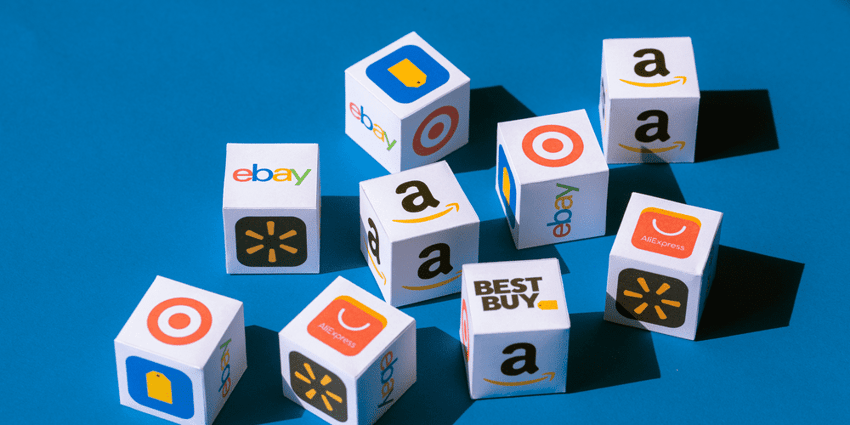$62.3 BILLION.
That’s how much was spent online for physical goods. According to the 2022 Inside Australian Online Shopping Report, four out of five households made a purchase on the web.
Building an ecommerce store or selling products on a marketplace is easier now than ever. Whether it’s for a side hustle to make some extra cash or a career path you’re passionate about exploring, plenty of options are available to get started.
But how do you know the best ecommerce platform to setup your store?
To help you choose the right place to sell products online, we’ve assessed all the major ecommerce platforms and provided recommendations so you can make an informed choice. Let’s take a look.
The Best Ecommerce Platforms & Marketplaces to Sell Online in Australia
An ecommerce platform allows businesses to create and manage an online store. It provides all the tools and features needed to sell products, such as catalogue management, payment processing, and shipping integration.
However, if you're looking to enhance your shipping strategy with faster fulfilment or access more advanced ecommerce shipping technology, like smart automations, courier comparisons, or bulk processing, you may still need a dedicated multi-carrier shipping solution alongside your platform.
The term "online marketplace" encompasses ecommerce websites or applications that streamline shopping experiences by aggregating products from various sellers. They play a pivotal role in connecting sellers with buyers and facilitating transactions. It's crucial to note that online marketplaces don't bear responsibility for inventory matters as they don't maintain their own. They also generate revenue through category referrals (in the form of commissions), subscription fees, and additional services.
1. Shopify
Shopify supports over 4.5 million stores across multiple industries. It features a user-friendly interface, dynamic themes, and an app store featuring everything you need to sell online.

Who Should Use Shopify?
Shopify is an outstanding choice for anyone looking to build an ecommerce store. It not only ranks among the most user-friendly platforms available today but also stands out as a feature-rich and all-encompassing solution.
The extensive selection of apps and enhancements within the Shopify marketplace guarantees that you can effortlessly enhance and expand your store's functionality over time. If you're searching for a secure and adaptable method to initiate online selling, it’s difficult to fault this option.
The Pros of Using Shopify
- User-Friendly: Shopify makes it accessible and straightforward for beginners and experienced web developers.
- Abandoned Cart Recovery: The inclusion of abandoned cart functionality on all Shopify plans is crucial for preventing lost sales.
- App Ecosystem: Shopify's app store covers dropshipping, marketing, and more. It empowers you to customise and optimise your store according to your specific needs.
- Built-in Email Marketing and SEO: The built-in capabilities are essential tools for effectively promoting your online store.
- Diverse Payment Gateways: Shopify allows you to cater to customer preferences by facilitating seamless transactions.
The Cons of Using Shopify
- Limited Free Themes: It features a small number of free themes compared to other builders, impacting your store's visual customisation options.
- Restricted "Product Options": Constraints on creating and managing "product options" can hinder the presentation of your products.
- Reliance on Apps for Enhanced Functionality: Installing various third-party apps to extend functionality can add complexity and costs to your store.
- Coding Knowledge for Custom Changes: Requiring familiarity with coding languages for implementing custom modifications can be a barrier for some users.
- Transaction Fees: High transaction fees on cheaper plans can significantly affect your overall profitability and should be considered in your budget planning.
2. Wix
Wix is known for its user-friendly approach and adaptability. It offers innovative features like AI-driven ADI, various payment options, mobile-optimised themes, and SEO tools. While it’s not the most advanced website builder, Wix's versatile Editor is gaining popularity among online sellers, allowing them to bring templates to life in unique and creative ways.

Who Should Use Wix?
Wix is an ideal choice for anyone seeking a straightforward way to sell products online. It provides a seamless and efficient way to get started swiftly. It even incorporates AI capabilities that guide you through the initial setup process, making it an accessible and user-friendly platform.
The Pros of Using Wix
- User-Friendly Backend: Wix is intuitive and beginner-friendly, making it easy for newcomers to start their online stores.
- Quick Setup: With simple setup options, Wix allows you to commence selling online promptly and is ideal for those who want to get started quickly.
- Customisation Options: Wix provides abundant customisation possibilities, enabling you to create a unique online presence.
- Rich App Market: The Wix app market offers a wide range of functionalities that enhance your store's capabilities.
- Affordability: Wix is recognised for its exceptional value, standing out as one of the most budget-friendly solutions for online sellers.
The Cons of Using Wix
- Loading Speed Concerns: Some Wix users have reported certain limitations in loading speed.
- Fewer Tools: Compared to some dedicated ecommerce solutions, Wix may offer a reduced toolset.
- Customisation Gaps: Some customers have noted the absence of specific options to customise their online store.
3. BigCommerce
BigCommerce offers an adaptable platform equipped with flexible features to accommodate your online store’s growth. It provides seamless integration with platforms like Amazon, eBay, Wish, and more to expand your client reach. It also provides themes and tools for tailored website design, in addition to robust security measures and comprehensive analytics to track performance.

Who Should Use BigCommerce?
BigCommerce is perfect for anyone aiming to establish a highly scalable online store in the Australian ecommerce market. It may not be the most straightforward platform to navigate, but it compensates by delivering comprehensive functionality. Plus, it offers advanced features such as abandoned cart recovery, ensuring you have the tools necessary to capture and convert potential customers, ultimately boosting your store’s success.
The Pros of Using BigCommerce
- Zero Fees: BigCommerce doesn't charge to use the platform, take any commissions for sales, or include transaction fees on any plan.
- Unlimited Staff Accounts: The platform offers unlimited staff accounts across all packages.
- Payment Gateway Integrations: BigCommerce seamlessly integrates with leading payment gateways.
- Marketplace and Social Media Integration: It allows easy connections to popular platforms like Amazon, eBay, and Facebook.
- Free Dedicated SSL (HTTPS): BigCommerce offers free site-wide HTTPS with a dedicated SSL certificate, ensuring secure transactions and customer trust.
The Cons of Using BigCommerce
- Learning Curve for Beginners: If this is your first online store, you may encounter a slight learning curve when using the platform.
- Complexity for Small-Scale Sellers: Some may find the product's complexity challenging, potentially affecting their ability to manage operations efficiently.
- Additional Costs for Certain Features: Some features come with additional costs, impacting budget considerations.
- Variable Customer Service Responsiveness: Customer service and support responsiveness may vary, with potential delays in addressing inquiries or issues.
4. Squarespace
Squarespace is a globally recognised website builder renowned for creating visually appealing websites that convey a professional image. While it may not offer the same drag-and-drop editing as some competitors, it is still relatively user-friendly. Online sellers can customise layouts and access ecommerce features such as automated discounts and abandoned cart recovery.

Who Should Use Squarespace?
Squarespace is an excellent choice if you want your ecommerce website to capture the attention of potential customers. This platform makes it simple to craft a professional-grade website and provides specialised tools to streamline the setup of recurring payments and subscription services.
The Pros of Using Squarespace
- Stunning Website Design: Squarespace stands out for its ability to help creative small business owners create visually impressive websites without requiring coding expertise.
- Reliable Performance: Squarespace offers exceptional reliability and performance, ensuring extended uptime for your website.
- Free Domain Name: The platform provides a complimentary domain name with the purchase of an annual plan.
- Built-in Security: Squarespace enhances user trust and security by including free WHOIS privacy and an SSL certificate with domain registration.
- Abundance of Ecommerce Features: Squarespace offers a rich set of ecommerce tools, from social media integrations to robust checkout systems and efficient inventory management, all without item limits.
The Cons of Using Squarespace
- Expensive: Squarespace's plans may appear costly compared to competitors, lacking lower-cost personal plan options available from some competitors like Wix.
- Loading Speed Issues: Some reviewers have noted that Squarespace's loading times can be slow at times, which can be problematic, particularly for mobile users who need speedy shopping cart interactions.
- Limited Payment Options: Squarespace offers limited payment options, primarily relying on Stripe, which may not suit your potential customers.
- Navigational Complexity: The platform aims to simplify website building, but beginners may still find it confusing initially, potentially experiencing challenges in navigating the process.
- Restrictive Templates: While Squarespace provides visually appealing templates, content block-based construction can feel restrictive, limiting users' control over content placement which may impact creativity and increase the learning curve.
5. WooCommerce
WooCommerce seamlessly transforms your WordPress site into a fully functional ecommerce platform. It offers an all-in-one solution including shopping cart functionality and product pages. The platform leverages the extensive WordPress library, offering numerous options to enhance the online shopping experience. Even without additional plugins, WooCommerce offers popular features such as support for omnichannel selling and the capacity to handle an unlimited number of products.

Who Should Use WooCommerce?
If you don’t want to pay a monthly fee with platforms like Shopify or BigCommerce, WooCommerce is a viable alternative. It includes dozens of customisation options and scalability with minimal effort or prior web design knowledge. You can create exceptional customer experiences, support bank transfers, and integrate review plugins and extra WordPress-compatible features. It also provides SEO tools for improved Google search results.
The Pros of Using WooCommerce
- Seamless Integration: WooCommerce integrates with your existing WordPress website using a free plugin.
- All-in-One Solution: It is a comprehensive offering with access to a diverse app store.
- Global Reach: Ideal for Australian ecommerce businesses seeking a global presence.
- Digital Marketing Tools: WooCommerce is equipped with multiple digital marketing and SEO tools.
- Payment Versatility: The platform offers multiple payment options for enhanced flexibility.
The Cons of Using WooCommerce
- Some Technical Proficiency Required: Using WooCommerce involves a learning curve that may demand some technical knowledge.
- Extra Costs: There are additional expenses associated with accessing third-party tools and features such as web hosting and premium themes.
6. OpenCart
Much like WordPress, OpenCart provides its core product and encourages you to tailor it to your specific needs through extensions. This free and flexible approach lets you cherry-pick the best apps that suit your business. While it’s a powerful and cost-effective solution, it does require some development skills to get the most out of the offering.

Who Should Use OpenCart?
OpenCart offers an intuitive interface, a clean dashboard, and an affordable entry point, making it an enticing choice for anyone looking to start selling online. However, it’s primarily designed for experienced developers offering access to unique customisation tools and a supportive community for those proficient in coding and web design.
The Pros of Using OpenCart
- Free Download: OpenCart is accessible to all at no cost.
- Highly Customisable: OpenCart allows for extensive customisation so you can tailor your store to your unique needs.
- Comprehensive Integration: It seamlessly integrates with leading tools and services to expand your store's functionality.
- Abundant Marketplace: You can access a diverse range of plugins, gateways, and tools to enhance your store's capabilities.
The Cons of Using OpenCart
- Developer Skills Required: Competency in web development is essential for effective usage.
- Limited Customer Support: While customer support is accessible, a significant amount of problem-solving falls on the user.
- Self-Hosting Responsibility: As an OpenCart user, you assume responsibility for development, maintenance, and more.
- Basic Marketing Features: OpenCart's SEO and digital marketing features are less extensive than some competitors.
- Speed Considerations: It is not the fastest option available in the market.
7. Amazon
Amazon needs no introduction. It’s a renowned ecommerce juggernaut with over 300 million active users worldwide. The marketplace’s global presence and comprehensive product categories make it ideal for brands seeking extensive reach.
Who Should Use Amazon?
Selling on Amazon offers access to a vast customer base, making it a top choice for ecommerce ventures looking to expand their reach and credibility. Some of the most popular products to sell on the marketplace include toys, games, clothing, and pet supplies.

The Pros of Using Amazon
- Increased Sales Potential: With over 58 million monthly visitors, Amazon is a massive shopping search engine offering enhanced visibility in a competitive market.
- Building Customer Trust: 50% of shoppers initiate their product searches on Amazon. Providing accurate and informative product content can drive more sales through the marketplace.
- Utilising Product Content: Amazon's robust ratings and reviews system positions it as a leading platform for customer feedback and product information.
- Streamlined Shopping Experience: Amazon's "cart and forget" feature allows customers to add items to their cart and decide later, enabling Amazon to send targeted cart reminders without additional costs to sellers.
The Cons of Using Amazon
- Branding Challenges: Establishing a distinctive brand presence can be challenging when selling on Amazon, often prompting sellers to use it as a supplementary revenue source for their primary website.
- Increased Competition: Amazon's appeal leads to heightened competition, necessitating a well-planned long-term strategy to compete with other sellers effectively.
- Order Management Complexity: Managing orders across multiple marketplaces can be intricate. Finding a tool that makes it easy to manage orders in a centralised system is essential to streamline the process.
8. eBay
Starting as an auction site, eBay has evolved into a comprehensive online marketplace for new product sales covering various product categories. It provides user-friendly features for newcomers including preset templates, pricing recommendations, and promotional tools, making it an attractive choice for many.

Who Should Use eBay?
Like Amazon, eBay presents an excellent opportunity to significantly enhance your visibility even if you're a newcomer. One of the marketplace’s advantages is its seamless cross-border purchasing process, allowing you to reach international customers while primarily operating within Australia. It could provide insights as to whether you should consider a global expansion.
The Pros of Using eBay
- Vast Audience Reach: eBay has 57 million monthly visits per month in Australia, providing sellers with access to a massive audience of potential customers.
- Featured Store Upgrade: The marketplace includes a featured store upgrade to enhance your product visibility significantly. Similar to Google Ads, it ensures that when potential customers search for specific keywords, your products will prominently appear on eBay's search page, driving increased traffic to your store.
The Cons of Using eBay
- eBay Selling Fees: eBay charges a monthly fee of $24.95 for a basic store setup, $54.95 for a featured store, and $549.95 for an anchor store. There are also fees for sales and payments.
- Intense Competition: The vast number of active users and sellers on eBay means you may encounter fierce competition. A well-thought-out listing and strategy is essential to distinguish your offerings in a crowded marketplace.
- Rules and Policy Restrictions: Selling on eBay means adhering to their predefined regulations and policies, limiting your control over critical aspects such as returns, refunds, and customer service.
9. Etsy
Etsy is the world's foremost online marketplace for artisans, craftspeople, and collectors. It features popular categories such as apparel and accessories, jewellery, crafts, and art supplies. It is also emerging as a promising sales channel for print-on-demand businesses.

Who Should Use Etsy?
The marketplace is ideal for ecommerce businesses selling handcrafted items, craft supplies, vintage goods, and unique designs. While you might not have the same autonomy as running a standalone website, Etsy offers a more straightforward setup process, making it an accessible choice for creative entrepreneurs and artisans seeking a broader audience for their original creations.
The Pros of Using Etsy
- Large Customer Base: Etsy's global reach ensures that your products are instantly exposed to a diverse audience worldwide.
- Cost-Effective Advertising: Etsy simplifies advertising by enabling sellers to establish a weekly budget, making it a low-risk investment.
- Comprehensive Search Analytics: Sellers benefit from robust analytics, particularly for optimising search engine visibility, allowing you to monitor the keywords driving traffic to your shop.
- Effortless Shop Administration: Etsy's user-friendly interface streamlines shop setup within minutes and simplifies ongoing store management and customer communication.
The Cons of Using Etsy
- Extensive Promotion Required: Given its niche focus, effective marketing efforts are required through channels like Facebook and Instagram to achieve success.
- Limited Customisation Options: Sellers must operate within the platform's constraints, limiting the degree of customisation for their listings and shops and causing them to blend together.
10. Facebook Marketplace
Facebook Marketplace is a compelling choice for ecommerce entrepreneurs. It offers a quick and direct route for sellers to connect with buyers. It's particularly beneficial for anyone selling physical items.

Who Should Use Facebook Marketplace?
As for the most successful categories on Facebook Marketplace, you might want to explore fashion apparel, furniture, home decor, mobile devices, or baby care products. These offerings are currently experiencing high demand, with fashion apparel standing out as one of the fastest-selling items on the platform.
The Pros of Using Facebook Marketplace
- Extensive User Base: Facebook has three billion monthly active users, making it a platform with unparalleled reach.
- Integrated Advertising: Leveraging Facebook's integrated advertising system, you can easily promote your listings and reach a more targeted audience.
- User-Friendly Experience: Selling on Facebook Marketplace is straightforward and requires minimal technical expertise. The intuitive process allows you to share your products within Groups as well.
- Cost-Effective: A significant advantage of using Facebook Marketplace is its free-of-charge nature. You won't incur fees for listing a product, and there is no limit on how many you can post.
The Cons of Using Facebook Marketplace
- Messaging-only Communication: Facebook Marketplace restricts communication to its chat system, whereas other platforms offer more diverse options like email or texting, which may be more convenient for certain customers.
- Lack of Bidding System: Facebook Marketplace primarily supports fixed prices or price ranges. Additionally, it's known for its reputation as a budget-friendly marketplace, often requiring sellers to compete on pricing.
- Absence of Seller Vetting: Facebook Marketplace lacks a feedback system for product or seller vetting, allowing anyone over the age of 18 to list items without a verification process.
11. Google Shopping
Google Shopping allows retailers to showcase and sell their products directly through the search engine without incurring commission fees. With this approach, customers can make purchases without leaving the Google ecosystem, providing increased visibility for your products and a smoother, more convenient shopping experience.

Who Should Use Google Shopping?
Google Shopping offers numerous benefits for online stores. It positions your product at the forefront with informative details that enhance purchase intent, providing a straightforward and effective advertising solution. Plus, it enables you to reach a broader audience compared to not running ad campaigns.
The Pros of Using Google Shopping
- No Commission: Google Shopping doesn't charge any commission fees, offering a free way to reach potential customers.
- Prominent Branding: Your store's information, including reviews and return policies, is displayed, ensuring transparency for shoppers and encouraging repeat business.
- No Competition From Google: Unlike Amazon, Google doesn't directly compete with its retailers, eliminating the threat of internal competition.
- Builds Customer Trust: The offering enhances brand visibility and builds customer trust as transactions occur through Google. Some products are backed by the Google Guarantee, which includes offering reimbursements for unsatisfied customers.
The Cons of Using Google Shopping
- Strict Shipping Guidelines: Google has stringent shipping guidelines requiring quick processing and transit times to stay competitive.
- Price Competition: Google Shopping encourages price comparisons, favouring lower prices.
- Low Visibility and Order Volume: It can be challenging to gain visibility and order volume without the ability to bid on products, making it essential to offer competitive prices.
- Integrating With Systems: Integrating new orders into inventory and shipping systems can be manual and unreliable compared to platforms like Amazon, which offer more seamless integration.
12. MyDeal
The popularity of MyDeal is rising with Australian online shoppers, boasting over 1000 sellers and a large customer base of half a million buyers. This marketplace primarily focuses on oversized items like sofas, dining tables, and mattresses while also offering various other products including fitness equipment and pet supplies.

Who Should Use MyDeal?
Selling on this marketplace comes with several advantages, including the convenience of having your listings and product presentation managed through the MyDeal storefront. Additionally, it provides opportunities for small business loans, offering financial support for various needs such as expansion costs or quick access to funding for seizing new opportunities.
The Pros of Using MyDeal
- Marketing Tools: MyDeal provides various marketing and advertising tools to help you effectively promote your products.
- Lower Commissions: MyDeal charges a monthly fee and a commission fee that varies based on the product, which can often be lower than other marketplaces.
The Cons of Using MyDeal
- Application Process: You need to fill out an application to apply to become a seller on MyDeal.
- Listing Policies: MyDeal has strict product listing policies, requiring you to ensure compliance with their guidelines.
- Limited Recognition: MyDeal may not be as widely recognised as other marketplaces, meaning you may need to increase marketing efforts to drive traffic to your listings.
13. Kogan
Kogan presents a comprehensive shopping destination for Australian consumers encompassing various departments such as home and garden, technology, fashion, and fitness. When registering as a seller, you'll need to decide whether to become a supplier for the platform or sell your own manufactured products.
Who Should Use Kogan?
Becoming a third-party seller on Kogan can offer a valuable opportunity to establish an online presence while allowing you the flexibility to concentrate on your brand development. However, it's important to highlight that Kogan primarily caters to established businesses and may be less beneficial for smaller independent sellers seeking a marketplace.

The Pros of Using Kogan
- Diverse Product Categories: The platform offers a wide range of product categories, allowing you to sell various types of items.
- Brand Recognition: Kogan had almost four million active customers in 2022 and continues to see steady growth year on year.
- Customer Support: The platform handles customer support to assist with inquiries or issues.
The Cons of Using Kogan
- Not Suited to All Sellers: The marketplace benefits established businesses compared to new smaller independent sellers.
- Commission Fees: Kogan charges a few fees plus a commission, which is negotiated once you become a seller.
- Lesser Visibility: Kogan is not as well-known as other ecommerce platforms, potentially requiring additional marketing efforts to attract traffic to your listings.
14. Grays Australia
Grays is a leading ecommerce platform in Australia specialising in industrial, automotive, consumer, and commercial goods sourced directly from manufacturers and distributors. The marketplace provides buyers with exceptional value and convenience while offering retailers an efficient sales channel to maximise the value of their assets.

Who Should Use Grays Australia?
Grays is a versatile marketplace with diverse categories spanning from engineering equipment to home and garden appliances, fashion, and much more. Sellers on this platform can receive expert guidance, including valuation services, project management, marketing support, and more, all aimed at optimising their sales.
The Pros of Using Grays Australia
- Range of Product Categories: Grays is an excellent marketplace for industrial, auto, consumer, and commercial goods, allowing sellers to list various items.
- Expert Support: Sellers benefit from a team of experts who can guide you on maximising sales in the marketplace, including valuation services, project management, marketing, and more.
- Liquidation Channel: Grays is known for its ability to help businesses sell excess stock or large assets efficiently.
The Cons of Using Grays Australia
- Not Ideal for Smaller Sellers: Grays Australia is more beneficial to established businesses and may not be as suitable for smaller or independent sellers.
- Complex Product Offerings: Managing diverse product categories can be difficult, especially for sellers with a wide range of items.
- Limited Branding Opportunities: The platform focuses on product listings, offering limited opportunities for sellers to build a distinct brand presence.
15. Catch
Catch is renowned for its fantastic daily deals and has been making waves since its arrival in 2017. Over the past few years, the marketplace has experienced remarkable growth and has become home to prominent brands like Speedo and The North Face.

Who Should Use Catch?
To become a seller on the platform, retailers must apply and undergo a vetting process to ensure alignment with the 'Catch Values.' Once approved, sellers can tap into a substantial customer base. While it may not rival giants like eBay in size, Catch offers an intriguing opportunity for businesses that excel in providing clearance deals and appealing to impulse buyers.
The Pros of Using Catch
- Large Customer Base: Catch has over three million active customers and 35 million monthly visitors, providing you with access to a significant audience.
- Deal-Oriented Shoppers: Catch is known for daily deals and discounts, attracting shoppers looking for bargains.
- Payment Security: Catch payments ensure secure and efficient payment processing for sellers.
The Cons of Using Catch
- Competitive Environment: The platform offers products from many big-name brands that can overshadow smaller retailers.
- Strict Compliance: Sellers must adhere to stringent listing and service standards, which may require additional effort.
- Limited Customisation: The platform offers limited customisation options for your storefront.
Start Selling Today
Establishing your own online store comes with both challenges and opportunities. But it offers immense fulfilment and profit potential when executed effectively.
The primary hurdle involves marketing your store and driving traffic to it. However, this approach allows you to craft a distinctive brand identity, setting you apart from being merely "a marketplace seller."
We recommend selecting a few secondary marketplaces to supplement sales while hosting your primary store on platforms like Shopify or WooCommerce and getting it off the ground.










 Facebook
Facebook Twitter
Twitter Instagram
Instagram Linked In
Linked In YouTube
YouTube